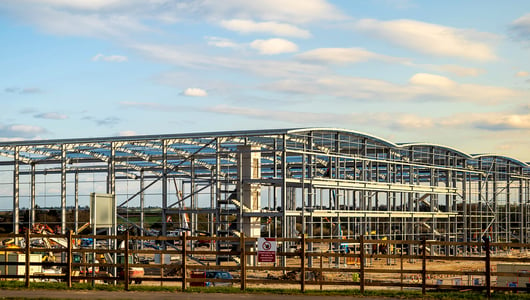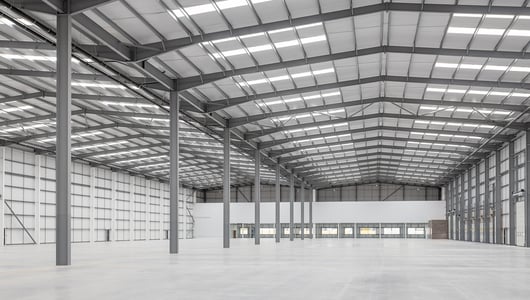Office market update Winter 2023

The flight to quality continues
In short: There has never been such a divergence between prime and secondary office space before. This is still being driven by companies downsizing due to changing working patterns, as well the need to meet higher net-zero requirements, drawing demand to the best-in-class buildings in terms of ESG. This is a structural change in the office sector which is still being absorbed, so capital values are still under pressure, but there is appetite among some investors for best-in-class office space, or secondary space where there opportunity for change of use.
UK office vacancy rate rises again. Some eye-catching leasing deals in the City of London in recent months has not been enough to offset the weak demand for offices across the rest of the country. The UK vacancy rate has edged up to 7.9%, up from 7.7% in August, and up from 5% before the pandemic. The weak demand, a result of more working from home and increased ESG requirements from companies as well as more challenging economic conditions, coincides with a strong pipeline of office stock. Some 10.8 million square feet of office space was delivered in the 12 months to the end of September, up from 8.8 million square feet in the previous 12 months.
There is currently more than 110 million square feet of vacant office space in the UK – the highest level in nearly a decade, and this will rise to 140 million square feet by 2025 according to CoStar.

Vacancy rates have edged up in all large key city markets in England in Q3, as shown in the chart above.
The impact of working from home has not yet been fully felt across the office market. Even though the number of office-based jobs rose 4.1% in the 12 months to Q1 this year, demand continue to be weak, signalling that firms are still adjusting to the seismic shift in mobile and hybrid working experienced during the pandemic.
While jobs numbers have proved resilient so far, the weaker economic outlook over the next year indicate there could be headcount reductions, putting further downward pressure on office demand.
Not all offices are the same however, and some are enjoying stronger levels of demand despite these headwinds in the market. These best-in-class offices are the best located with top amenities and ESG ratings, helping them entice workers into the office, and meet the their own challenging net-zero goals. Outside London, the office market clustered around Cambridge and Oxford corridor is particularly strong.
Capital Economics highlighted the two-speed office market earlier this year when it noted the expanding spread between prime and non-prime office assets in the South East, which reached 160 points in Q1 2023.
Prime offices have propped up rental growth, along with increased incentives from landlords for occupiers such as longer rent-free periods. However, the challenges in this market which is currently characterised by high levels of supply and weaker overall demand will put downward pressure on rents through 2024.
London office leasing activity picked up in Q3, but even so, net absorption was still in negative territory as the volume of stock being delivered to the market outpaced a series of large lettings deals. The vacancy rate continues to climb and is now at a 20-year high of 9.2%, up from below 5% at the start of 2020. Delivery levels are set to remain high, meaning the vacancy rate is unlikely to fall into 2024. But as with the UK market, there is a clear distinction between best-in-class office space in the capital, compared to poorer quality stock.

Location is also key across the capital – with several large leasing deals in the city, including Kirkland & Ellis, the law firm, taking 174,000 of option space at 40 Leadenhall underlining the attraction of the City, even as the vacancy rate is in low double digits. The Corporation of London recently highlighted the potential for more tall towers in the city, underlining the confidence in this geography in spite of the headwinds. To the east, the vacancy rate in Canary Wharf and Docklands is at 14%, rising to 19% for the fringe areas, as several large companies, including HSBC, have opted to shrink their floorplate and move west into the city.
In the West End, a tighter supply of office space has kept the vacancy rate relatively low. In turn, areas with lower vacancy rates are seeing more upwards pressure on rents, but rental rises remain modest.

As can be seen in the chart above, MSCI data shows that average rents for central London offices have started to rise. However, this masks what is happening under the headline in terms of location and type of building. There are many examples of rents stagnating or declining for buildings that fall below the best-in-class standard due to increasing supply outside the West End. The large pipeline of space coming online in the City will put downward pressure on rents, even as demand remains resilient, while rents in Canary Wharf, where the vacancy rate is highest, will come under most pressure. The increasing supply of smaller Cat A plus buildings, for which there is good demand, may also be putting some upward pressure on headline rents, as these can command higher rates.
WeWork, a very large occupier of office space in central London, with 2.89 million square feet over 36 buildings, filed for bankruptcy in early November. It says this action relates only to the US, but the company has significant space in the north of the City of London, and in Southbank. The BBC reported that it was closing an office close to Blackfriars south of the river. Markets will be watching as the company attempts to renegotiate its leases.
Investment levels pick up slightly. The strong start to the year in office investment wasn’t sustained, falling back in Q2. Investment levels rallied a little in Q3, but on an annual basis, investment in offices is still at a 14-year low at £8.8 billion. Higher financing costs, higher vacancy rates and weaker sentiment are acting as a drag on prices and activity, especially for non-prime assets, and are likely to continue to do so until halfway through next year. The appetite for prime assets is slightly stronger, and yields for these assets has stabilised, especially where investors can take advantage of lower entry prices.
There could be more stock coming to the market, especially secondary stock, as owners choose to divest rather than re-finance. Property funds are also divesting assets, with higher outflows than inflows of offices from open-ended property funds for the last 16 of 17 quarters, according to a recent report from React news. Increased stock levels will put further downward pressure on capital values.
There was also a slowdown in investment levels in Manchester in Q3, with investment in offices in the year to the end of September totalling £261 million, down from the five-year average of £588 million, and £1.3 billion registered in 2021. But in line with the prevailing trends in the market, the exceptions in this downbeat landscape are well-located prime assets, especially where there is wider regeneration or development. For example, in August, Sensible Properties Limited purchased Cardinal House, 20 St Mary’s Parsonage for £11 million from The Derwent Group. St Mary’s Parsonage, to the north of Spinningfields and close to the river is undergoing regeneration. Another exception is the sale of One Angel Square (329,000 square feet) which sold in late October 2023 for £140 million at an net initial yield of 8% – one of the largest single-asset transactions outside London for several years.
The appetite for business and science parks let to life sciences remains stronger than traditional offices, meaning pricing has held up better, especially in areas around Oxford and Cambridge.
In London, investment levels have also slowed. The rolling annual total of investment into the capital to Q3 was just £7.5 billion, the lowest level since 2009. The stronger West End market bucked the trend to an extent, accounting for more than half of office deals in Q2 this year, worth £600 million.
Demand is strongest where there is also an opportunity for re-development or adding value, creating Grade A office space in locations which are still showing healthy levels of demand. Overseas investors are also seeing opportunity, given the relative weakness of the pound to the dollar.
Brookfield, the Canadian asset manager, bought 77-78 Grosvenor Street for £100 million in June 2023, with an eye to redevelopment later this year.
But in less buoyant markets, investment conditions are tougher. Cheung Kei was reported by Bloomberg to be looking for a buyer for 20 Canada Square for £250 million, after purchasing the property for £410 million six years ago. It has now called in receivers for the building. However, it is not all downbeat, as Brookfield has fully let it’s Cargo building at 25 North Colonnade, which it redeveloped after purchase in 2014, and is now seeking a buyer.


Key investment deals:
| Property Address | Town /City | Date | Yield (%) | Sale Price (£m) | Buyer |
|---|---|---|---|---|---|
| 142-150 Wardour Street, W1 | London | Q3 2023 | £132m | Hines | |
| Old Broad, Lion Plaza EC2 | London | Q3 2023 | 6.0% | £209m | Lion Plaza Propco Ltd |
| 32 Jamestown Road, NW1 | London | Q3 2023 | 5.4% | £75m | |
| 1 Sovereign Street | Leeds | Q3 2023 | 7.0% | £38.5m | Citi Private Bank |
| The Halo, Temple Street | Bristol | Q2 2023 | 5.6% | £72.3m | CBREIM |
| St James Square, Dalton Place | Manchester | Q2 2023 | 5.8% | £30m | Karrev Real Estate Fund +1 |
Key statistics:
| Offices Q3 2023 unless otherwise stated | Central London | Manchester | Key Regional cities |
|---|---|---|---|
| Current Quarter (last quarter/5 yr av) | Current Quarter (last quarter/5 yr av) | Current Quarter (last quarter/5 yr av) | |
| Occupier | |||
| Availability rate | 10.6% (10.7%/9.4%) | 10.9% (11.1%/10.2%) | 9.7% (9.7%/8.9%) |
| Vacancy rate | 9.9% (9.8%/6.6%) | 9.2% (8.8%/6.9%) | 7.9% (7.9%/5.8%) |
| Rental growth % annual | 1.38% (1.56%/0.2%) | 3.9% (1.3%/3.4%) | 2.4% (2.8%/3.7%) |
| Quarterly take up sqft | 1.9m (1.9m/2.6m) | 0.34m (0.46m/0.48m) | 1.04m (0.86m/1.4m) |
| Prime headline rent per sqft Q4 2023 | £130 psf (West End) £82.50 psf (City) | £40 psf | £42 psf (Bristol, Birmingham) £37psf (Leeds) £29 psf (Newcastle) |
| Average rent per sqft | £62.23 (£61.64/£59.84) | £20.89 (£20.53/£19.00) | £20.02 (£19.96/£18.52) |
| Supply | |||
| Completions (net delivered) sqft | 763,378 (-68,000/741,000) | 228,145 (0/146,125) | 252,600 (261,579/542,474) |
| Total under construction sqft | 9.0m (10.0m/8.1m) | 1.6m (2.0m/1.8m) | 2.9m (2.9m/4.0m) |
| Investment | |||
| Quarterly Sales volume £ | £581m (£789m/£1.7bn) | £40m (£1m/£138m) | £210m (£197m/£418m) |
| Average yield % | 4.5% (NIY) | 7.4% | 8.5% |
| Prime yield % October 2023 (Q2 2023) | City: 5.5% – 5.75% (5.25%) West End: 4.0% – 4.25% (3.75% – 4.0%) | 6.25% – 6.5% (6.0%) | 6.25% – 6.5% (6.0%) |
The information provided in this report is the sole property of Cluttons LLP and provides basic information and not legal advice. It must not be copied, reproduced or transmitted in any form or by any means, either in whole or in part, without the prior written consent of Cluttons LLP. The information contained in this report has been obtained from sources generally regarded to be reliable. However, no representation is made, or warranty given, in respect of the accuracy of this information. Cluttons LLP does not accept any liability in negligence or otherwise for any loss or damage suffered by any party resulting from reliance on this publication.
Related research

Commercial market update Spring 2024
It’s now widely accepted that interest rates have peaked, the key question now is when will the central bank start to cut rates, and how low will they go in the coming year.
Office market update Spring 2024
The structural change in the office market is ongoing, with strong appetite for best-in-class office space which meets high net-zero requirements and insipid demand for secondary or tertiary space. The investment market was quiet overall in 2023, although some notable deals were struck where pricing was competitive.
Retail market update Spring 2024
Take-up rose towards the end of 2023, but overall vacancy rates are flattered by the lack of supply in the market. The bright spot for landlords is luxury retail and retail parks, where consumer demand is still relatively stronger.
Industrial market update Spring 2024
Vacancy rates creep up and rents ease. The recalibration of the Industrial market after the pandemic uplift continues, but overall, the sector continues to outperform compared to other asset classes.
Economic update Spring 2024
The economy grew more than expected in November, according to the latest data from the ONS, but there is still a risk that the UK could dip into recession.
Commercial market update Winter 2023
The Bank of England’s decision to keep the base rate on hold at 5.25% for the second consecutive time in November has raised the prospect that interest rates are at their peak.
Industrial market update Winter 2023
Slowing rental growth. Robust occupational market conditions amid tight supply are helping to maintain a continued confidence after significant repricing in the sector.
Retail market update Winter 2023
Slowing market. Prime high street assets are among the best performing within retail – these assets have stabilised and there is opportunity for future rental growth where values have been rebased.
Commercial market update Autumn 2023
Will they? Won’t they? This is the key question around whether the UK’s base rate will exceed 5.75%. There have been enough mixed messages to muddy the waters – inflation data released in June showed that inflation was stuck at 8.7% in May, which prompted forecasts that the base rate would peak at 6.5% from the current rate of 5.25%.
Office market update Autumn 2023
UK office vacancy rate continues to climb. Weak demand and strong supply are resulting in an ever-rising vacancy rate for offices across the UK, which has hit 7.7%, up from less than 5% before the pandemic.
Retail market update Autumn 2023
The retail environment remains challenging. The rising cost of living, and recent disappointing weather have led to a further tick down in overall sales.
Industrial market update Autumn 2023
Vacancy rate remains low. Net absorption of industrial space dipped into negative territory in Q2 2023 for the first time in 11 years as take up fell back to levels last seen before the pandemic.
UK economic update Autumn 2023
The key economic move over the last few months was the Bank of England’s decision not to raise interest rates in September.
UK economic outlook Q3 2023
The economy settled down relatively quickly from the shock of the mini-budget in September last year and the resulting spike in gilt rates and mortgage rates.
Commercial market update Q2 2023
The UK’s economic mood music has been more upbeat so far this year than many would have anticipated in the wake of the mini-budget last year. This culminated in the IMF, traditionally circumspect about the UK’s economic outlook, confirming in late May that the country would not enter recession this year, contrary to its earlier forecasts.
Office market update Q2 2023
Office take-up gained some momentum towards the end of Q1 as employees continue to return to the workplace in greater numbers. But overall demand for office space remains muted compared to historical norms.
Retail market update Q2 2023
Retail sales fell back in May after rising slightly in April, according to a survey from the CBI, but the overall outlook is slightly more upbeat than at the beginning of the year as consumer confidence continues to climb and the prospect of lower energy bills is factored in.
Industrial market update Q2 2023
Average industrial property yields, according to MSCI, which softened sharply last year remained largely unchanged in Q1 2023, as the market absorbed the new economic landscape in the UK.
UK economic outlook Q2 2023
Higher than expected inflation dampens expectations for UK economy. Inflation data was higher than expected in May, which has weighed on business confidence, and has pushed interest rate expectations, and the cost of borrowing, higher.
Commercial market update Q1 2023
The bond vs property yield spread ticked up in Q4 but remains nearly the narrowest in a decade.
Retail market update Q1 2023
Retail sales ticked up slightly in January but are still down on a three-monthly basis from the post-pandemic highs in the summer of 2021.
Industrial market update Q1 2023
The strong performance in this sector over the last few years mean that the upheaval caused by rising interest rates and the September’s mini-budget, which caused a surge in gilt yields, was more pronounced than other sectors.
Office market update Q1 2023
UK office vacancy rate rises, but masks a two-tier market.
UK economic outlook Q1 2023
The economic outlook for the UK is challenging this year, but there is growing consensus that the downturn will not be as long as previously expected.
Commercial market update Q3 2022
Bond yields have settled down, but property yields are exposed to some repricing as investors take into account higher borrowing costs.
Industrial market update Q3 2022
Rents and capital values surged this year in response to high levels of demand for occupiers and investors alike.
Office market update Q3 2022
The central theme in this sector is the flight to quality by investors and occupiers alike.
Retail market update Q3 2022
This sector was hit hardest by Covid and the cost-of-living led recession will likely deliver another blow.
Commercial market update Q2 2022
Economy is slowing and, early suggestions that we may avoid recession have been swept aside by the Bank of England following on from their August meeting.
Office market update Q2 2022
New hybrid model or edging back to prior status quo?
Industrial market update Q2 2022
Average industrial yields largely held steady for Q2, with the South East at 2.9% and the rest of the UK at 4.2%.
Retail market update Q2 2022
Will recession torpedo Covid recovery?
Industrial market update Q1 2022
The rent rise continues: If the classical economists’ definition of inflation being ‘too much money chasing too few goods’ needed a perfect illustration that the industrial sector is it.
Office market update Q1 2022
Historically there has been a very strong link between employment growth and increased demand for office space. The employment market is one part of the economy that is weathering the current storm well.
Retail market update Q1 2022
with so many bad news headlines over the cost-of-living crisis and geopolitical uncertainty, it is no surprise that consumer confidence has faltered and dramatically so.
Commercial market update Q1 2022
The commercial real estate sector has been through an extraordinary year, outperforming other asset classes with total returns of 23.9% over the past 12 months.
Commercial market update Q4 2021
It has been a long pandemic, and Omicron provided a sharp reminder that it might not be over quite yet. Despite this, there are signs of recovery in all sectors.
Industrial market update Q4 2021
Rental growth continues to rise, hitting 7.2% a year in Q4 2021. Industrial space under construction is at the highest level ever recorded.
Office market update Q4 2021
Large year-end London office deals show confidence in the outlook, but TfL passenger volumes took another hit from Omicron in December.
Retail market update Q4 2021
Slide in retail rents halts, but inflation and interest rates pose a threat as cost-of-living bites.
Connecting the UK
We partnered with YouGov to survey MPs and councillors about the Government’s gigabit rollout plans and the challenges involved in meeting the national targets. In addition, we surveyed businesses and consumers to gain insight into the level of understanding around gigabit capable technology and awareness of the benefits that gigabit connections can bring.
Retail market report Q3 2021
Retail capital values over the last three months have grown by 3.2% (the strongest quarterly rate since 2010) with values stabilising across all retail segments.
Office market report Q3 2021
There are emerging signs of polarisation in the office market between top spec buildings versus those of a lower quality.
Industrial market report Q3 2021
Industrial investment flows are now not only ahead of the same period in 2020 but also significantly ahead of 2019 levels, driven by the continued strength of investor interest in the logistics sector.
Return to the office
For several years pre-pandemic the homework rate was around 5%, compared to 1% in 1981. It rocketed to 37% in April 2020 and remains high as pandemic restrictions ease.
Retail market report Q2 2021
Retail yields have repriced as average UK retail yields are now 6.8% which compares with 5.3% five years ago.
Office market report Q2 2021
Financial service companies are seeking out the best model for hybrid working, with 79% of financial service firms surveyed by CBI/PWC in Q2 2021 reassessing their workspace needs and 82% are planning on implanting hybrid ways of working.
Industrial market report Q2 2021
Investment volumes in the industrial sector over last 12 months increase by 75% as investment levels in the sector have soared.
UK retail market review Q4 2020
Internet sales are 56% higher than they were in February 2020. Non-food store sales are 27% lower than at the start of the pandemic however, despite this, traditional retailers are continuing to grow their online presence and shrink their bricks and mortar portfolios.
UK office market review Q4 2020
UK office market more resilient than expected with declines in values less severe than commentators had predicted.
UK industrial market review Q4 2020
Demand for industrial and warehouse space is driven by the economic performance of the retail, logistics and manufacturing sectors.
UK retail market review Q3 2020
2020 has been a difficult year for bricks and mortar retail. It is a commonly repeated aphorism but nonetheless true that the pandemic together with Lockdown 1.0 and 2.0 have crammed five or more years of anticipated changes in markets into the last nine months.
UK industrial market review Q3 2020
The drivers of demand for industrial real estate will continue to evolve.
UK office market review Q3 2020
Structural changes effecting the UK office market will play out over several years.
UK office leasing review Q2 2020
Coronavirus leads to dramatic declines in leasing activity.
UK office investment review Q2 2020
Transaction volumes decline during lockdown.
UK retail leasing review Q2 2020
Landlords and tenants shared the strain of pandemic lockdown. COVID-19 is accelerating the trend in the shake-out of retail.
UK industrial & distribution review Q2 2020
Transaction volumes declined during lockdown, with investment into distribution most favoured.
UK retail investment review Q2 2020
Retail investment market shuts down during the COVID-19 lockdown.
The commercial connectivity impact report
The majority (65%) of the UK’s commercial landlords have undertaken work to improve the digital connectivity of their buildings, with almost three quarters (72%) of tenants saying that poorly connected offices will become obsolete spaces.
London office market outlook autumn 2018
ons has released its London Office Market Outlook report for autumn 2018, which looks at the health of the office sector by examining some of the key performance indicators.
Autumn budget 2018
The Chancellor unveiled the 2018 Autumn Budget on 29 October, the last before Britain officially leaves the EU in March next year. In our response document, we present our view on some of the key announcements.
London office market outlook summer 2018
Cluttons has released its London Office Market Outlook report for Summer 2018.
The London connectivity report – part one: residential tenants 2018
Cluttons has published the first part of The London Connectivity Report, focusing on residential tenants, carried out in partnership with YouGov.


